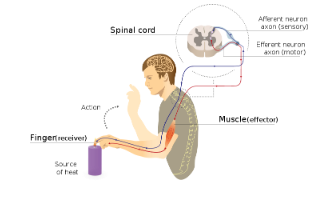
What is meant by reflex-action? With the help of a labelled diagram trace the sequence of the event which occurs when we touch a hot object.
Answer
486k+ views
Hint: The word “reflex” is commonly used when we talk about sudden action of response to something in the environment, that is a sudden withdrawal of the body part which comes in contact with objects that are hot, cold or sensed dangerous to us.
Complete step-by-step answer:
A sudden withdrawal of body parts that come in contact with hot, cold, animals, pointed objects, etc. (a sudden response to the stimuli). The complete process of response to peripheral nerve stimulation, which happens involuntarily (without conscious thought or effort) and requires the involvement of the part of the CNS, is called reflex action. This reflex is made possible by a neural pathway called the reflex arc.
The reflex pathway consists of at least one afferent neuron (receptor) and one efferent neuron (effector) appropriately arranged in a series. The afferent neuron receives an impulse/signal from a sensory organ. This impulse is transmitted to the central neuron system through the dorsal root. From the CNS the efferent neuron carries the signal to the effector. This pathway of stimulus and response form a reflex arc.

Note: All the impulses received by the dendrites of the neurons. These impulses move away from the cell body, axon and synaptic terminal. From the terminal, the signal or impulse is sent to the next interneuron with help of the neurotransmitter. The interneuron is also called a relay neuron. Example of a neurotransmitter is acetylcholine.
Complete step-by-step answer:
A sudden withdrawal of body parts that come in contact with hot, cold, animals, pointed objects, etc. (a sudden response to the stimuli). The complete process of response to peripheral nerve stimulation, which happens involuntarily (without conscious thought or effort) and requires the involvement of the part of the CNS, is called reflex action. This reflex is made possible by a neural pathway called the reflex arc.
The reflex pathway consists of at least one afferent neuron (receptor) and one efferent neuron (effector) appropriately arranged in a series. The afferent neuron receives an impulse/signal from a sensory organ. This impulse is transmitted to the central neuron system through the dorsal root. From the CNS the efferent neuron carries the signal to the effector. This pathway of stimulus and response form a reflex arc.

Note: All the impulses received by the dendrites of the neurons. These impulses move away from the cell body, axon and synaptic terminal. From the terminal, the signal or impulse is sent to the next interneuron with help of the neurotransmitter. The interneuron is also called a relay neuron. Example of a neurotransmitter is acetylcholine.
Recently Updated Pages
Master Class 10 General Knowledge: Engaging Questions & Answers for Success

Master Class 10 Computer Science: Engaging Questions & Answers for Success

Master Class 10 Science: Engaging Questions & Answers for Success

Master Class 10 Social Science: Engaging Questions & Answers for Success

Master Class 10 Maths: Engaging Questions & Answers for Success

Master Class 10 English: Engaging Questions & Answers for Success

Trending doubts
A boat goes 24 km upstream and 28 km downstream in class 10 maths CBSE

Why is there a time difference of about 5 hours between class 10 social science CBSE

The British separated Burma Myanmar from India in 1935 class 10 social science CBSE

The Equation xxx + 2 is Satisfied when x is Equal to Class 10 Maths

Chandigarh is the capital of A Punjab B Haryana C Punjab class 10 social science CBSE

Change the following sentences into negative and interrogative class 10 english CBSE




